
Boston Tea Party
Tryon Palace
Postal Service
American Revolutionary War
Declaration of Independence
Common Sense
Battle of Moore's Creek Bridge
US Flag
Articles of Confederation
Battle of Guilford Courthouse
State of Franklin
The Constitution
Industrial Revolution
George Washington
North Carolina Statehood
First Census
Whiskey Rebellion
Raleigh, New Capital
Walton War
Louisiana Purchase
War of 1812
Year Without a Summer
Panic of 1819
Missouri Compromise
Andrew Jackson
Second Great Awakening
Oregon Trail
Trail of Tears
Improved Transatlantic Mail
James Polk
Mexican-American War
Fugitive Slave Act
Underground Railroad
Panic of 1857
Pony Express
Act of Secession
Civil War
Homestead Act
Lincoln Assassination
13th Amendment
First Transatlantic Cable
The Lowry War
Heinz Ketchup
Blue Jeans
Typewriter
Telephone
Jim Crow Laws
Time Zones
Mary Jenkins
Abraham Stephenson
1770
1800
1830
1860
1890
Benjamin Thomas Stephenson
Benjamin Thomas Stephenson
Benjamin Thomas Stephenson
Benjamin Thomas Stephenson
Edith Jenkins
Jenkins Stephenson
Sally Stephenson
Elizabeth Susan Stephenson
ENABLE STORY WIZARD
Benjamin born, 1788
Benjamin was born in 1788, in North Carolina, United States. His mother was Mary Jenkins and was 39 years old when Benjamin was born. His father was Abraham Stephenson and was 38 years old at the time. Benjamin was the youngest of three children. His older siblings, Jenkins and Amy, were 13 and 12 years old when he was born.
North Carolina, 1788

During the 1700s, many immigrants from England relocated to North Carolina in search of religious freedom. A large state, North Carolina is covered mostly in rolling hills, coastal plains, and mountains. The Atlantic Ocean to the east facilitated trade, shipbuilding, and fishing during this time. With only around 250,000 settlers living in North Carolina during the 1700s, Benjamin's community consisted mostly of plantation owners, farmers, and ship builders.
Industrial Revolution, 1760 - 1830

Cotton Mills

28 years before Benjamin was born, the Industrial Revolution began to take Europe and North America by storm. Countless technological advancements were developed, including the steam engine and the cotton mill. The efficiency of the steam engine, along with newly-dug canals, lowered the cost of trade goods and transportation and facilitated commerce and travel between Benjamin's country and the rest of the world. While the Industrial Revolution brought many new inventions to light and allowed the world to progress industrially, it also created negative consequences such as massive job loss due to industrialization, pollution from factories, and increased urban poverty.
Edith Jenkins born, 1789
Benjamin's future wife, Edith Jenkins, was born 1 year after Benjamin. Edith was born in Northampton, North Carolina, United States.
George Washington, 1789

Benjamin was 1 when the new American Congress unanimously selected George Washington as the first president of the United States. The majority of the general populous already adored Washington for leading the colonies to victory in the Revolutionary war, and they found his humble approach towards leadership ideal for the Presidency. With the goal of avoiding the rise of another tyrannical monarchy, many Americans in Benjamin's region believed Washington had the integrity needed to move the U.S. away from its British roots. In the years that followed, Washington's steady hand would set the precedent for how the United States could be fairly governed.
North Carolina Statehood, 1789

An early rendering of the seal of North Carolina
When North Carolina joined the United States of America in 1789, Benjamin and his friends and neighbors found themselves residents of the twelfth state in the country. North Carolina did not agree to the Constitution of the United States until months after the new national government was running successfully, as local leaders opposed a strong central government. Unfortunately, their own state constitution heavily favored wealthy slave-owning planters, leaving the rest of the state itching for revolution. The Federal Constitution superseded some of those laws, reducing the legal imbalance between the well-off and the less wealthy within Benjamin's community.
Childbirth

A baby in a cradleboard
Benjamin's mother faced significant risks when giving birth to him. Although the women in Benjamin's community gave birth to between six to eight children, as many as 20 to 30 percent of newborns died during infancy. Many of those who survived this dangerous stage of life then succumbed to diseases such as smallpox, influenza, or measles. Infections occurring during or immediately after childbirth took many lives during this time, and doctors were generally helpless in the face of these illnesses. A lack of practicing physicians in rural North Carolina, coupled with the popular belief that the presence of a man during childbirth was indecent, meant that midwives performed the majority of in-home births.
During Benjamin's lifetime, no painkillers were used to sedate mothers, aside from alcohol. Another belief in the community held that hard work made for easier labor; therefore, women did not hesitate to spin thread, weave cloth, and lift heavy objects while pregnant. Women in North Carolina did make liberal use of their herb gardens, which grew well in the climate. They used sage to prevent premature labor, while large doses of tansy oil was a secret, but sometimes deadly, way of inducing abortion. Around 1735, those in major cities began buying books on medical treatments, usually created by medicine manufacturers. A popular one was published in 1736: Every Man His Own Doctor: or, The Poor Planter’s Physician.
Pregnant Native American women of this period went to a special hut and lay upon a reed mat and furs, assisted by several other experienced women. Once the baby was born, the umbilical cord was sewn into a deerskin packet that hung on the baby's cradleboard. The cradleboard was a type of fur-lined bassinet that was flat, elaborately decorated, and carried on the mother's back.
First Census, 1790
In 1790, when Benjamin was 2, President Washington ordered the first census in the history of the United States. Census enumerators visited the homes of people around Benjamin to collect information such as the name of the head of the household and the number of free people and slaves living at each residence.
Childhood

Children in colonial attire
Growing up on the colonial frontier,Benjamin's young relatives and neighbors did not have the luxury of a relaxing, carefree childhood. Even children from wealthier backgrounds had to contribute to the greater needs of their families. Most working-class and rural families had many children, because more children meant more contributors to help the family survive and prosper. Boys from farm families helped with the crops or livestock, while in the towns, they worked under the supervision of their mother or father to learn a trade. Some boys started grammar school around age 8, and many men taught their sons how to wield a gun, a compass, and an ax. Educational and occupational options for girls were much more limited, and most women focused on teaching their daughters to spin, knit, and cook. Parents could be very demanding and sometimes quite harsh with their children. In their spare time, colonial children living near Benjamin found fleeting amusements: leapfrog, skipping, tag, races, hide-and-seek, and other simple games.
Many Native American boys in Benjamin's region played with miniature bows and arrows and looked forward to hunting and fishing with their fathers. Girls made dolls from beads, cloth, bark, and roots. Both boys and girls played "snow snakes," a game in which participants threw carved sticks as far as they could. In addition, young Cherokee men played a version of stickball called Anejodi. The Catawba played Lacrosse, and the Natchez played a spear-throwing game called chunkey.
Enslaved African American children living near Benjamin's were not shielded from the horrors of plantation life. White slave owners often removed slave children from their homes and sold them to other owners, never to be seen by their parents again. Other white families took African American children from their parents to serve as playmates for their own children. Slave children did not get an education and were expected to perform heavy work like their parents. When they did have time to play, children played games like follow the leader and others that only required materials that they could gather easily, such as stones or sticks.
Whiskey Rebellion, 1794

Whiskey Rebellion
In order to help pay for the debt burden of the Revolutionary War, Secretary of Treasury Alexander Hamilton introduced a tax on liquor, which was passed by Congress in 1791. Farmers across the country were furious about this tax, and felt that the rich politicians of the east were taking advantage of poor westerners. The tension and unrest came to a head in 1794, when a group of 400 rebels attacked the home of a tax collector. President Washington responded swiftly and powerfully by sending a militia of nearly 13,000 men to put down the insurrection. Washington's actions showed people like 6 year-old Benjamin that the new government was strong, and that dissension and rebellion would not be tolerated.
Raleigh, New Capital, 1794

The Capitol building at Raleigh
North Carolina's original capital, New Bern, was located on the coast. However, Benjamin's fellow North Carolinians soon realized that the capitol building, called the Tryon Palace, was vulnerable to attack by sea. Therefore, members of the state government agreed that the capital should be moved. During the Revolutionary War, the North Carolina legislature had eluded the British by rotating among different locations, including Raleigh—which at that time was simply an oak grove. As Raleigh was located near the university at the center of two important roads, the town was chosen in 1792 to be the permanent site of the new state capital. The local legislature hired architect David Paton to rebuild an earlier Raleigh building for the government's use. Paton created corridor ceilings that helped make the first floor resistant to fire. Residents of Raleigh enjoyed watching the construction of the new capitol building, and were proud of its traditional architecture when it was opened to the public in 1794, when Benjamin was 6.Education

A building on the campus of UNC Chapel Hill
During Benjamin's childhood, one-room schoolhouses were common across the South, with one teacher presiding over students of all grades and ages. These schools were privately run by churches, parents, or towns. Wealthy North Carolinians often sent their children abroad for a good education, while lower-class children tended to do trade apprenticeships lasting anywhere from three to ten years. In 1795, the University of North Carolina at Chapel Hill opened to the public and became the nation's first state university. However, these educational opportunities were not open to all young people living in North Carolina: African Americans were legally forbidden from receiving an education or even learning to read.
Native American children living near Benjamin's got their education at home. With the help of their entire tribe, most began at a very young age to learn about plants, herbal medicine, household chores, and how to interact with animals. Fathers taught their sons about fishing, trapping, and hunting, while little girls learned how to make wigwams, chop wood, gather food, prepare animal skins, and create elaborately decorated objects through sewing and beading.
Holidays

Settlers give holiday greetings
Holiday celebrations in North Carolina during Benjamin's lifetime were a time to take a break from hard labor and enjoy the season and one another. Originally, the only inhabitants of North Carolina were Native Americans, who also took part in their own festivities. Generally, these celebrations were held during a season or time of year, rather than on a specific day. Though the various tribes had different celebrations, some activities and principles were similar. Most tribes held pow wows, in which hundreds of people gathered, sometimes for hours or days, to dance and enjoy art. The Cherokee and other tribes honored the arrival of spring with the Green Corn Dance.
Colonial settlers in the frontier did their best to celebrate Christmas, Easter, and other traditional holidays. However, in a land of mostly wilderness, and few, if any, houses of worship, celebrations were often small and informal. For the winter holidays, Benjamin's colonial neighbors enjoyed a meat pie—a rare treat— which contained salted meats, onions, potatoes, and apples.
Holidays were also celebrated by dancing, feasting, and giving gifts. Presents played a modest role in Christmas celebrations, but some were given to children and servants. Over time, gift-giving became an increasingly common practice. It was rare to see a Christmas tree during Benjamin's lifetime, although there were a few. Wealthy planters celebrated by holding large feasts featuring succulent dishes such as mutton, beef, pork, and minced pies; they drank beer, wine, or cider. This feast was often accompanied by dancing to fiddle music and gambling on a game of cribbage. The less-wealthy settlers in the rural areas also found festive ways to enjoy Christmas, Easter, and other traditional holidays, although their gatherings were not as elaborate. There were also many who hardly took notice of Christmas or other special occasions and simply continued their daily toil.
Hygiene

Soap advertisement from the late 1800s
Throughout the 19th century, hygiene routines in Benjamin's North Carolina community still involved outhouses, chamber pots, unheated baths, and untreated water. People living in industrial cities and small towns alike suffered from unhealthy living conditions. Housing shortages caused many working-class families to live in cramped quarters lacking running water, and diseases like tuberculosis, consumption, and diphtheria ran rampant.
As Benjamin got older, he saw some improvements in mainstream hygiene practices, as his neighbors began to bathe more frequently—at least once a week. While some families heated their bathwater by the bucket on the stove, others bathed in cold water for the convenience. Most people also washed their faces, necks, and hands twice daily using basins, washcloths, and pitchers of cold water kept on washstands in their bedchambers. While handmade soaps made from animal fat, wood ash, and natural soda were mainly used for laundry, Benjamin's family gradually began to use them for bathing, as well. Occasionally, flower petals were added as an anti-odor product.
North Carolinians also began to brush their teeth more frequently, as new companies created a growing market for manufactured dental hygiene products like toothbrushes and toothpaste. In the early part of the century, a lack of formal licensing procedures allowed anyone to set up shop as a dentist. In 1842, a college-educated dentist finally opened his professional services to the public in North Carolina. However, the public would not be urged on a wide scale to see to their dental health until the next century.
Walton War, 1802

A monument to the fallen soldiers of the Walton War
In the late 1700s, North Carolina accepted a twelve-mile parcel of land called the "Orphan Strip" from the federal government. As it was a dangerous land with little government oversight, North Carolina did little with it. In 1802, the land was given to Georgia, and Walton County was established. The area was improved upon, and other states, such as South Carolina and North Carolina, soon turned their attention to it. As some of the strip's boundaries had never been determined, both sides claimed it, and Benjamin's friends and neighbors watched as the "Walton War" soon unfolded. Following two clashes, the Battles of McGaha Branch and Selica Hill, wherein the Georgians sustained losses, a North Carolina constable was killed. Benjamin's fellow citizens watched the North Carolina militia respond to the death by taking over the area's government. In 1807, a joint commission determined that the land belonged to North Carolina, which then extended amnesty to the supporters of Walton County, ending the skirmish.
Clothing

An example of Victorian fashion for women

Fashion trends in the United States went through many variations during Benjamin's life, but there were some consistencies that spanned economic classes, with both frontier men and wealthy urban businessmen often favoring a formal look, with long wool frock coats and trousers, vests, large bow ties, and sturdy leather boots. Women on a wagon train might wear a long, one-piece cotton or wool dress in a flower print or plaid pattern, with a bonnet, an apron, and/or a shawl as accessories. Victorian styles influenced American women, too, with many sporting elaborate, frilled ankle-length skirts, camisoles, petticoats, form fitting jackets, and highly restrictive corsets. Hats were worn by most of the men Benjamin knew, be it a Lincoln style silk top hat, a simple straw cap, or a western cowboy hat. Long beards and mustaches, well coiffed, were also common.
Religion
Religion played a large role in local and national governments in the 1800s. Popular religions in America, such as Methodism, Baptism, and Roman Catholicism, contained almost 70% of religious Americans at the time. While many sects and religions harbored ill feelings towards other religions, preachers and the faithful created new sects of Christianity, which promoted greater religious diversity in the states. Many of Benjamin's friends and neighbors attended church regularly and practiced fervently, which brought church communities closer together.
Louisiana Purchase, 1803

When Benjamin was a teenager, President Thomas Jefferson bought the Louisiana Purchase from France for $15 million and doubled the size of the United States overnight. This massive acquisition of land was a bargain at less than 4 cents per acre that opened the West to the booming immigrant population and new opportunities for all Americans to make a living. The land included in the Louisiana Purchase forms all or part of 15 current states.
Marriage
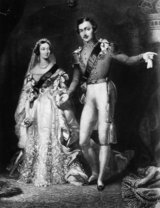
Queen Victoria's 1840 white wedding gown inspired today's traditional gowns

Marriage was an essential part of life for many people in Benjamin's community. A shared religious background, culture, race, and class often determined courtships and relationships. The courting process was very rule-oriented, and it was generally the man who made the first move and showed interest in the woman. Boys and girls alike began courting as early as fifteen or sixteen, and married in their early to mid-twenties. Over time, views of marriage slowly evolved, and rather than having unions arranged, love became the guiding principle for most relationships in Benjamin's community.
The wedding itself was a simpler affair in the early 1800s, but by the end of the century, many of Benjamin's fellow North Carolinians married with style. Despite their charming beginnings, not all marital relations were ideal. Many were cut short due to death, disease, and war. As women faced such a high likelihood of dying in childbirth, couples had only a one-in-three chance of living together for more than ten years. Desertion and unfaithfulness were common problems made worse by society's negative view of divorce. Gradually, though, divorces did become easier to obtain during Benjamin's lifetime, and were granted in instances of adultery, cruelty, and desertion. In the 1800s, the laws also changed to allow a woman custody of her children if she had not committed any wrongdoings, whereas before she had little rights whatsoever. North Carolina also had various anti-miscegenation laws, making interracial relationships illegal. Society continued to uphold traditional family roles, with the mother raising the children and keeping an orderly home, while the father worked and provided for the family.
Native American marriage customs differed between tribes, but generally, the family of the husband-to-be arranged the union. The two young people were chaperoned whenever they met – in fact, the young man usually had to speak to the woman in front of her entire lodge. Sometimes men created a piece of music and played it for the courted woman, or brought gifts for the family. Marriage within the family clan was forbidden, except occasionally between cousins. Typically, there was only one husband for each wife, and marriage required no ceremony in many of the tribal cultures. In the Cherokee wedding tradition, the couple exchanged corn and venison to symbolize their intent to provide and care for the household. Parents of the married couple also exchanged gifts, and if the relationship did not work out, the man simply left the household to signify the separation. If a Cherokee woman wanted a divorce, she placed her husband's belongings outside the home.
African-American slaves had a decidedly more difficult path to marriage, if they could get there at all. Slaves were sold at any time, and even if they ended up in neighboring plantations, they could not visit their spouse without permission. To marry, slaves had to secure approval from the master, and they would sometimes have a ceremony and move into a cabin together. If permitted, a black plantation preacher performed the ceremony, followed by a feast and dancing in the slave quarters. A popular tradition of "jumping the broom" was sometimes followed, wherein slave couples hopped over a broomstick to signal they were truly married. They viewed this jump as binding, and there were variations of it throughout the South.
Entertainment
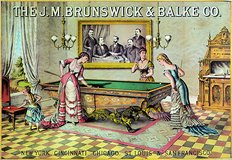
Advertisement featuring ladies playing billiards
Benjamin's friends used hobbies, games, and other pastimes to cope with the hardships of daily life. During the 1800s, entertainment varied widely by location and social class. The wealthy enjoyed leisure activities including billiards, reading literature, and playing backgammon. North Carolinians of the working and middle classes played inexpensive card and dice games in their free time. Wealthy or not, parties and dinners were popular. Some of these centered around activities or events, such as making candy, a housewarming, barn raising, or sledding. North Carolina began having state fairs in 1853, and they became tremendously popular; these were halted during the Civil War, only to resume in 1869.
During the same period, local Native American tribes also had ways of having fun. Natchez men played with balls of boiled tree sap, while children organized games to improve their hunting skills, including attempting to throw a spear through a hoop. Cherokee people played a version of stickball, while the Shawnee were famed for their storytelling. They also focused heavily on arts and crafts, such as baskets made out of river cane or reeds. Some Native American tribes adopted the colonial pastime of cards.
The Appalachian region of North Carolina pioneered the popular activity of square dancing, beginning in 1812. All sorts of dances were devised with charming names, such as "Cage the Birdie" or "Shoo-Fly-Shoo." Dances were sometimes accompanied by banjo music and had a "caller" who shouted out the moves. Originally these dances were simply done to celebrate events such as a birth or wedding, but in time, people made the dance itself the focal point of a celebration. The folk music played with these dances also became an entertainment form enjoyed among many in Benjamin's community.
Diet
It's no coincidence that Americans started eating better and expanding their palates at the same time that technology was improving transportation and hygiene. While Benjamin knew many people who still relied on subsistence farming, those same farmers could also now sell and ship their food to cities far and wide. Some popular new foods, like Rocky Mountain oysters, stayed regional. Others, like peanut butter, corn bread, fried chicken, and flavored soda water, slowly spread across the country, sold at local groceries and restaurants. Food purchased at a store could then be taken home and prepared safely using an open hearth or cast-iron gas stove.
Military
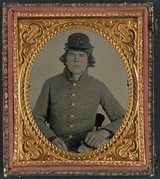
A young North Carolina Civil War soldier
Although there was very little U.S. military activity in Benjamin's state during the early 1800s, increased clashes between soldiers and Native American tribes eventually prompted the government to send more soldiers to the area. As the century progressed, escalated conflicts, and eventually the defense of cities during the Civil War, made North Carolina an important military zone.
Earlier in the 19th century, militiamen in North Carolina served in the war of 1812. The pay ranged from $8-$12 per month, an enlistment bounty, and 160 acres of land after the war. There was no official uniform for the military at the time, so men wore their own clothing. This usually was comprised of a shirt made of coarse twill, dyed blue, yellow, or brown. Pants were made from a durable cloth suitable for work, and leather belts often held a tomahawk, which white settlers had adopted from Native Americans. They used powder horns, butcher knives, and hunting rifles. These soldiers were not prepared for winter, and often resorted to wrapping themselves with blankets and wearing slouch hats to protect themselves from the cold.
Prior to the Civil War, North Carolina opened military institutions to train officers, including the North Carolina Military Institute and the North Carolina Military Academy. The idea of a military private education was a popular one, and these schools trained many men who would later be involved in the Civil War.
During the years surrounding the Civil War, the comparatively few Union sympathizers generally fought with Enfield or Smithfield rifles, which were reloaded between each shot with paper cartridges. Meanwhile, Confederate soldiers usually fought with whatever gun they owned, typically a hunting rifle. When the war broke out, many different companies competed for Union government contracts, and soldiers wore a variety of colors and designs, until the government settled on the familiar blue uniform. North Carolina's Confederates wore homespun clothing, usually dyed a yellow-brown color from the butternut tree; this led to them being called "butternuts" by Union soldiers.
Disease was a greater threat to the lives of soldiers than the battlefield itself. The lack of any mental health care during the period led to countless North Carolinian families torn apart by alcohol abuse and what would eventually come to be known as shellshock, or post-traumatic stress disorder.
Medicine
Benjamin lived during a time of great medical progress, as increased understanding of human anatomy was helping doctors and scientists come up with better solutions for many of the diseases, infections, and unsanitary conditions plaguing American life. The stethoscope was invented around this time, along with blood transfusions, cholera vaccines, laughing gas, and a number of new anesthetics. Those of Benjamin's friends that lived in or near large towns or cities benefited much sooner from these advances than those that lived in more rural areas.
As a further issue, only a handful of medical colleges and hospitals existed in the United States during Benjamin's life, and high infant mortality rates— along with often devastating outbreaks of chicken pox, measles, mumps, and whooping cough— kept the average lifespan barely above 40. Death, to put it bluntly, was a very common part of life.
In another morbid part of 19th century life, some of Benjamin's deceased friends or family may have actually been buried with a shovel or pickaxe in their coffin. Why? Because with many doctors still not able to diagnose whether a patient was in a coma, relatives wanted to be sure the dearly departed had a fighting chance just in case he woke up after his funeral!
War of 1812, 1812
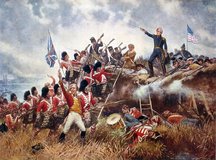
Battle of New Orleans

When Benjamin was 24, the War of 1812 broke out between the United States, Canada, and Great Britain. Britain was attempting to regulate American trade on the open ocean, and Canada joined the war as a British protectorate and ally. Although nothing was technically changed by the end of the conflict, around 15,000 of Benjamin's fellow countrymen were killed in battle. However, the War of 1812 was followed by an age of great national pride called the "Era of Good Feelings".
Son Jenkins born, 1815
In 1815, Benjamin's son, Jenkins, was born when Benjamin was 27 years old. The family was living in North Carolina, United States at the time.
Year Without a Summer, 1816
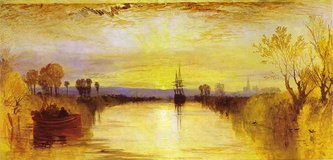
Some theorize that this period painting shows how the sky looked during this summer

Due to an eruption of a volcano, Mount Tambora, in Indonesia, temperatures in the summer remained unusually cold across America in 1816, and food production suffered. People in Benjamin's community felt significantly cooler temperatures that summer with occasional frosts in the traditionally warm months of May, June, July, and August. Parts of the southern United States had average summer temperatures around 45 degrees fahrenheit. A dry fog that would not go away with rain hung in the air, reddening the sky.
The volcano had shot ash into the stratosphere, above the earthly weather patterns, and this ash hung there for the year. Some people moved elsewhere in order to find a more hospitable area to grow food, but were disappointed to find the extent of the weather phenomenon. Benjamin's community, like many others, experienced a religious revival as people looked to faith for an explanation of the unusual weather. Interestingly, the conditions also spurred the creation of some of the world's most famous horror writings, including Mary Shelley's "Frankenstein" and Lord Byron's poem "Darkness."
Household
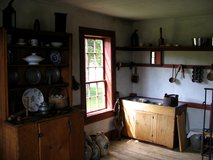
Kitchen
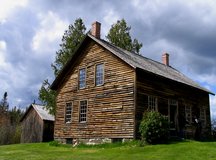
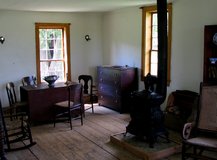
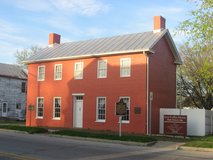
Throughout Benjamin's life, housing was changing and evolving as Americans were pushing toward a distinct identity. Since settlers came from Germany, France, Spain, and England, housing was dictated by wealth and varied architecturally—but framed timber or rock was generally used. For Benjamin's friends and family, beds were made individually with no standard size and held mattresses stuffed with either straw or feathers. To heat the house, a chimney was placed in the middle of the home, doubling as a stove.
Typical houses had two rooms, but some families could afford two-story homes (with separate bedrooms for parents and children) or even stately manors on par with some of the nicer homes in Europe. Families generally had tables where they would sit to eat their meals. Most furniture was custom-made, but later in the 1800s, it became easier to purchase affordable, mass-produced goods with which to furnish a home.
Panic of 1819, 1819
When Benjamin was 31, he lived through the first major peacetime financial crisis in the United States. After the War of 1812 and the economic bubble that followed, a deep depression hit the United States. Since swelling crop yields in Europe caused imported food to be cheaper than home-grown food priced at and purchased with inflated currency, people were forced off their farms and out of their homes due to bank failures and foreclosures. During Benjamin's life, prisons became overcrowded with debtors who were locked up after failing to pay their bills.
Transportation
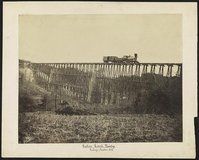
An early North Carolina train and train bridge
Benjamin's friends and family did not have many transportation options if they needed to travel beyond their own homes. In general, moving around was difficult enough that most travelers were traders, settlers, farmers bringing crops to market, or others whose livelihood depended on travel. Most North Carolinians traveled on foot, unless they could afford a horse and cart. Throughout the 1800s, many took advantage of North Carolina's waterways to get to their destinations. Birch-bark canoes, made of bark wrapped around a wooden frame, were fashioned out of local materials. Dugout canoes cut from a single tree were also used across the state. Trains did not reach the region until 1836, when the railroad connected Wilmington to Raleigh. North Carolina's railways would later become vital to the Confederate cause during the Civil War.
The only roads available to Benjamin's family were cleared-out paths originally made by local Native American tribes; these trails were difficult and time-consuming to travel on, especially in bad weather. By the mid-19th century, a 129-mile wooden road called the "Farmer's Railroad" had been completed between Fayetteville and Bethania. North Carolina soon came to focus much more on roads and ports that did other states in the South. Wilmington became a major port, and roads were planked all over the state. Plank roads soon became very popular among North Carolinians, despite the addition of tollbooths and the tendency to plank only the one-way roads leading into, and not away from, towns and cities. Getting from one place to another, generally, was still a treacherous ordeal filled with mud, bumps, and poor visibility.
Daughter Sally born, 1820
In 1820, Benjamin's daughter, Sally, was born when Benjamin was 32 years old. The family was living in Northampton, North Carolina, United States at the time.
North Carolina, 1820

During the 1800s, many immigrants from England and other countries came to North Carolina in search of religious and economic freedom. Despite North Carolina's wide variety of landscape including rolling hills, mountains, and coastal plains, its proximity to the Atlantic Ocean meant that trade, ship building, and fishing were the major industries during this time. Around 800,000 Americans lived in North Carolina during the 1800s; Benjamin would have lived and worked with farmers, millers, plantation workers, and ship builders.
Missouri Compromise, 1820
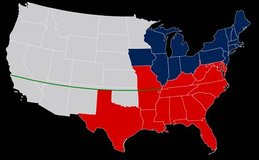
In 1820, when Benjamin was 32, the Missouri Compromise was passed by the United States Congress. By this point, slavery had become a very divisive issue, as representatives of the North looked to prevent pro-slavery regions from gaining statehood, while many Southerners sought to expand the slave trade further west. In this agreement, Missouri was granted statehood with slavery declared legal within its borders. But as a trade-off, Maine joined the Union as a free state, and slavery was forbidden in all other land north of the 36°30' parallel. In the short term, the compromise was honored. But few people on either side were pleased, as the moral objections to slavery grew louder in the North, while some Southern farmers felt cut off from opportunities in the Northwest.
Transportation
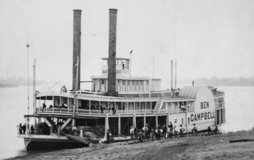
Steamboat
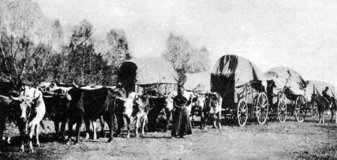
As more of Benjamin's friends and family traveled west during American expansion, technology made some significant leaps to help them get there. What started with river boats and wagon trains quickly evolved into canals and railroads, as both people and goods were transported with a speed and efficiency never before possible. A century that started with Lewis and Clark's slow journey into the unknown eventually led to the first coast-to-coast railroad by the late 1860s. For day to day life, though, most people around Benjamin still relied on traveling by foot—with only the occasional horse, buggy, or wagon for longer trips.
Jenkins Stephenson dies, 1822
Benjamin's sibling Jenkins Stephenson passed away in North Carolina, United States at the age of 47. Benjamin was 34.
Communication
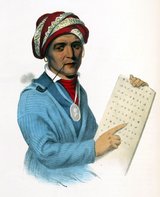
Sequoyah
Keeping in touch with loved ones or following important news stories required a lot of patience during Benjamin's lifetime. Some newspapers were printed, but as circulation was limited and much of the population was still illiterate, word of mouth was still the best way to spread vital information.
Long distance communication was especially difficult for people in the rural South. Until the 1850s, postal officers operated out of their homes and delivered letters by horse. Many of Benjamin's neighbors didn't even bother with the postal service, and instead relied on surveyors, explorers, and hunters to carry messages across the land. Eventually, the development of the telegraph, railroads, and steam-powered ships toward the middle of the 19th century helped information move at a much faster pace. This technology simply wasn't available during much of Benjamin's life, however.
In North Carolina, the local accent and figures of speech varied by location. In general, the long “i” tended to sound more like “ah,” and "r"s were often left out after vowels. Near the Pamlico Sound, the area was so isolated that residents had a Cockney accent from British English. In addition, they spoke words not used elsewhere in North Carolina: “pizer” for porch, and “meehonkey” for a game of hide-and-seek. Ocracoke residents sometimes spoke in opposites, such as saying "It's a lovely day" to mean "It's raining cats and dogs."
The Cherokee tribe living near Benjamin spoke a dialect of the Iroquoian language family, which was not used by many other southern tribes, making communication with those outside of the tribe difficult. Even closely connected tribes speaking related languages often developed wildly different dialects, making it difficult for members of different tribes to understand one another, let alone visiting colonial settlers. In 1821, Sequoyah—a Cherokee silversmith—introduced a written Cherokee language. Many members of the tribe began studying the language, and soon thousands of Cherokee were literate.
Daughter Elizabeth born, 1828
In 1828, Benjamin's daughter, Elizabeth, was born when Benjamin was 40 years old. The family was living in North Carolina, United States at the time.
Politics
While much of the political news of Benjamin's day revolved around the increased American expansion into the West, there were major developments on the homefront, as well. Women, while still excluded from the vote or holding office, began taking a more active role in politics, with many helping to found reform groups concerned with everything from women's rights and healthcare to child labor and temperance. Still, with the country's power predominantly in the hands of white male landowners and a polarizing two-party system taking hold, many key debates over civil liberties were left in limbo, including landholding rights of Native American tribes and the right of freedom for African slaves in the South.
Commerce
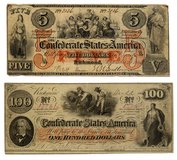
Confederate money
Many new towns and cities were established across North Carolina during the early 19th century. As the population grew, some members of Benjamin's community stopped subsistence farming and began working as manual laborers or in trades such as smithing and tanning. Tourism also became possible for those with the money and the leisure time. In the 1830s, Nags Head became a popular summer resort for the elite in Benjamin's state.
The federal government originally only minted coins and did not issue paper money, but the United States Mint still struggled to keep up with demand. Later, during the Confederate period in North Carolina, many people in Benjamin's region found that the prices of everyday items had shot up, and that some items were no longer available at all. In addition, over the course of the Civil War, the money issued by the Confederate government dropped in value until it was almost worthless.
Bartering was still common through much of Benjamin's life, and many farmers exchanged their crops for goods to ensure they got something of value from the trade. New advances in agricultural technology also made it possible for farmers living near Benjamin to harvest more crops in a fraction of the time.
Andrew Jackson, 1828
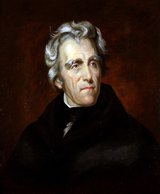
In 1828, when Benjamin was 40, Andrew Jackson was elected President of the United States. Jackson was born in the backwoods of North Carolina and, at the time of the election, was best known as a war hero. He was the Democratic-Republican presidential nominee that year, and many North Carolinians around Benjamin were thrilled to hear that he won the presidency by a landslide.
One of Jackson's most significant decisions as president was the elimination of the Bank of the United States. There is no doubt that the Panic of 1837, which ruined many speculators, was caused by this elimination, but it is possible that the economy of the United States was unsustainable with the bank in place, since so many smaller institutions relied on that single bank.
Arguably Jackson's most famous political move, however, was the Indian Removal act of 1830, which ostensibly forced thousands of Native Americans to leave their lands in the east for new reservations west of the Mississippi. During 1838-1839, many tribes, including the Cherokees, were pushed form their homes and forced to make the long trek along what is now known as "The Trail of Tears." Over 4,000 Native Americans died on the arduous journey.
This action, along with Jackson's aggressive, sometimes violent, political style (he was known for dueling and threatening opponents) left him with a mixed, sometimes negative, legacy. Regardless of the popular opinion of Jackson, it is undisputed that he set a new precedent for the executive office, as he was one of the first presidents to use his veto power to control Congress, instead of simply following its lead.
Clothing
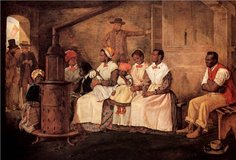
Typical slave clothing in 1853
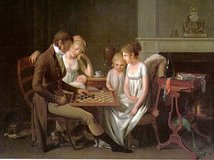
Fashion trends in the United States changed drastically during Benjamin's lifetime, but there were some consistencies that spanned economic classes. Both frontiersmen and wealthy urban businessmen typically favored a formal look, including long wool frock coats paired with trousers. Vests, large bow ties, and sturdy leather boots were also popular. Hats were worn by most of the men in Benjamin's community, from silk top hats to simple straw caps and western-style cowboy hats. Well-groomed long beards and mustaches were also common. Women might wear a long, one-piece cotton or wool dress in a flower print or plaid pattern accessorized with bonnets, aprons, and shawl. Victorian styles from England influenced American women, as well, in the mid to late 1800s, and some of Benjamin's female neighbors sported elaborate, frilled ankle-length skirts, camisoles, petticoats, form-fitting jackets, and highly restrictive corsets. Women in Benjamin's community did not particularly enjoy the discomfort of corsets and layers of skirts, but the majority submitted to the demands of fashion and social expectations. Because expensive store-bought clothing was a luxury, women in North Carolina's Appalachian region wove their own cloth on large looms they kept on their front porch.
During this time period, Native American tribes began to incorporate European trade objects, such as beads, silk, and silver, into their artwork and clothing. Before the Civil War, enslaved African-Americans in Benjamin's community were issued clothes twice a year, in spring and autumn. These garments were originally made of inadequate, cheap homespun cloth. Slaves who worked in their masters' houses typically received higher-quality clothing. All slaves also wore plain leather shoes and occasionally hats, and women often wore cloth head wraps or beads if they could get them. Very young children wore plain gowns, while older boys wore breeches. Girls wore gowns until they moved to adult dresses. By the mid-19th century, slaveholders began issuing clothing made from jean cloth rather than homespun. After emancipation, former slaves wore any clothing they could make themselves or that they received from employers.
Second Great Awakening, 1830
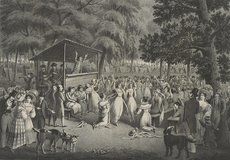
A camp meeting during the Second Great Awakening
When Benjamin was in his 40s, he lived through the Second Great Awakening, a Protestant revival movement of the early 1800s. Prompted by deteriorating religious excitement and lack of faithful devotion in the United States, numerous preachers traveled the country and gave lectures to crowds assembled in large camp meetings in an attempt to overcome the religious indifference and skepticism of many Americans. This new-found religious fervor produced thousands of new members in existing churches and also formed the foundation of new denominations such as The Church of Jesus Christ of Latter-day Saints (Mormonism). The abundance of religious options opened alternative spiritual doors for Benjamin and his community.
Oregon Trail, 1830
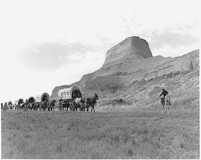

The Oregon Trail guided numerous people west to the Oregon territory starting in the early 1800s, with a steady increase in traffic when Benjamin was in his 40s. At first, only trappers and traders passed through the trail on horse or by foot, but by 1836 settlers organized the first wagon train and crossed the trail. Until the completion of the Transcontinental Railroad in 1869, pioneers used the Oregon Trail as their main means of transportation into the territory, typically to the Willamette Valley in the western half of Oregon. Seasoned travelers shared stories of the trail's demanding nature and disheartening trials with prospective migrants.
Trail of Tears, 1836 - 1839
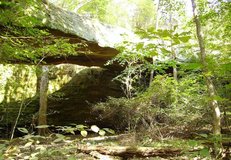
Thousands of Native Americans camped here for weeks in 1838 as they waited for the right weather to cross the Ohio River
When Benjamin was 48 years old, a dark chapter in American history began in the Southeast: the largest forcible displacement of Native Americans from their homeland to reservations our west. After years of tense coexistence between white settlers and Native Americans, President Andrew Jackson passed the Indian Removal Act, forcefully evicting all tribes east of the Mississippi River. The Muskogee tried to relocate to the mountains of North Carolina, but many were tracked down by American soldiers. Over 12,000 of the Native Americans evicted were Cherokee, and a missionary present at their military removal described tribal members being dragged from their homes with only the clothes on their backs. Plunderers followed in the wake of the military, ransacking houses once the Native American residents were forced from them.
Around a third of the Cherokees, Muskogees, Choctaws, Chickasaws, and Seminoles that were forced to relocate died during the 1,200 mile-long winter march from the Southeast to Arkansas and Oklahoma. At several points during the ordeal, groups had to wait for ice to form to allow them to cross major rivers. Those that survived what would become known as the Trail of Tears were forced to live on hostile reservations far from the land that had been their home for hundreds of years.
Improved Transatlantic Mail, 1840
On July 17, 1840, when Benjamin was 52, a 63 meter-long wooden steamship arrived in Halifax, Canada just 12 short days after leaving Liverpool, England. Its arrival in Boston only a few days later proved that steamships could make the Liverpool-Halifax-Boston mail route in only 14 days and 8 hours, much faster than a sailing ship. The use of steamships along the route allowed correspondence from people in Benjamin's community to be delivered faster than ever before.
James Polk, 1844

In 1844, when Benjamin was 56, North Carolina's own James K. Polk was elected President of the United States. Polk was born in Mecklenberg County, North Carolina, and was largely known for his heroism in the Mexican-American War and the annexation of the Southwest. Polk was the Democratic presidential nominee, and many North Carolinians around Benjamin were thrilled to hear that he won the presidency. Polk was a strong leader who met many of his stated goals, including having only one term in office. Polk's successes included striking a land deal with the UK to add Oregon to the country and opening the Smithsonian Institution, the Independent Treasury, the Washington Monument, and the US Naval Academy.
Mexican-American War, 1846 - 1848
When Benjamin was 58 years old, relations between Mexico and the United States were extremely volatile, especially following the annexation of Texas and disputes over the Texas/Mexico border. United States General Zachary Taylor pushed troops to the Rio Grande under the assumption that it was the Texas border, but Mexico did not agree. The Mexican government viewed the American troops as an invading force and sent their own army to push them out. The forces collided in the Battle of Palo Alto, the first battle of the Mexican-American War. Congress officially declared war on Mexico following the battle, but the move was not universally supported. Some Americans, including future president Abraham Lincoln and many other Northerners, believed that President James K. Polk had provoked the fighting with his rogue stance on the border. Abolitionists also felt that the war was an attempt to continue the expansion of slavery by providing more territory and power for slave owners. Many people who opposed the war tried to resist paying additional taxes to fund the military.
Regardless of the general disapproval, the war raged on. Using the same superior weaponry and tactics that had won the conflict at Palo Alto, American troops were able to defeat Mexican soldiers again at the Battle of Resaca de la Palma. The Mexican army, led by General Antonio López de Santa Anna, continued to lose battles and men, as the United States pushed further into Mexico. General Winfield Scott led the United States army into Mexico City and attacked Chapultepec Castle. The intense military pressure forced Santa Anna to relinquish his post, and the fall of the Mexican capital on September 17th, 1847, marked the end of the fighting. The Treaty of Guadalupe Hidalgo was signed on February 2nd, 1848, officially ending the war. The treaty awarded the United States an additional 525,000 square miles, over half of Mexico's land, including either all or parts of present-day Arizona, California, Colorado, New Mexico, Nevada, Wyoming, and Utah. In addition, Mexico was forced to recognize that Texas was a part of the United States (although this had technically been official for three years) and the border of Texas was set as the Rio Grande. In return, Mexico received a payment of $15 million for the land handed over to the United States (also known as the Mexican Cession). The land gained allowed American settlers to push further across the continent, and helped further the ideals of Manifest Destiny.
Fugitive Slave Act, 1850

Fugitive slaves
By 1850, when Benjamin was 62, the rise of the Northern abolitionist cause in American politics had some leaders in the South calling for secession from the Union. In an attempt to ease these tensions and maintain Southern loyalty, Congress passed the Compromise of 1850, which included an update to the country's existing "Fugitive Slave Act." The new laws reduced the rights of runaway slaves, offering rewards for their return and requiring citizens to assist in their capture. While some slave owners were pleased with the compromise, abolitionists and many politicians in the North were outraged. Rather than easing North/South tensions, the risk of a division in the Union looked more and more like an inevitability.
Underground Railroad, 1850
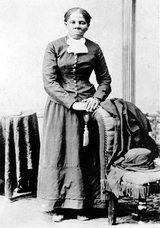
Harriet Tubman, an Underground Railroad leader
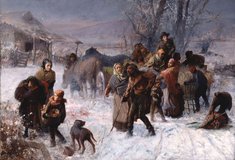
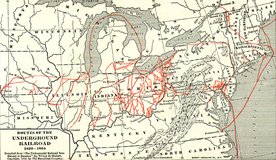
When Benjamin was in his 60s, the Underground Railroad was working at full force to secretly transport escaped Southern slaves into free Northern states. Vigilance committees in larger cities like New York, Philadelphia, and Boston were also forming to help provide food and supplies to these newly free men and women. By 1850, it is estimated that around 100,000 slaves had escaped using the Underground Railroad's network of travel routes and shelters. Supporters of the railroad saw it as a great cause for justice and morality, but many plantation owners—viewing slaves as property—considered the network a form of organized thievery.
Panic of 1857, 1857

When Benjamin was 69, the entire U.S. and much of the world was rocked by the Panic of 1857—a devastating economic recession that put thousands out of work. The great boom of the railroad industry and gold rush in the 1800s led to this inevitable bust, as mines dried up and overstretched railroad companies collapsed—costing investors millions and preventing farmers from shipping their goods back east. Within one year alone, more than 5,000 American businesses folded, as rising unemployment took its toll on many of Benjamin's friends and family.
Pony Express, 1860
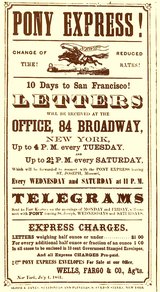
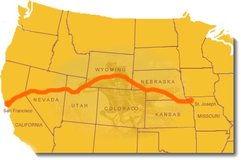
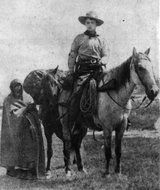
When Benjamin was 72, people across the country were abuzz about the implementation of the Pony Express, which revolutionized the exchange of information throughout the western United States. Instead of a haphazard system using unrecorded horses, the Postal Service established relay stations throughout the West that provided a place for riders to sleep and switch to fresh horses. Though this system drastically improved the speed at which Benjamin and his friends received mail and information, it was proved obsolete in 1864 when the transcontinental telegraph allowed for instant transfer of information.
Act of Secession, 1861
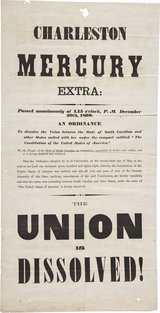
A broadside announcing North Carolina's secession from the Union
Benjamin's home state of North Carolina seceded from the United States of America on May 20, 1861. Initially, those pushing for secession were considered extremists, and public sentiment was not on their side. Benjamin's neighbors had attended meetings for both secessionists and unionists, with many leaning towards staying within the Union. Anti-Lincoln fervor in North Carolina soon strengthened, however, and the state excluded the Republican nominee from the presidential ballot in 1860. When Lincoln won the presidency anyway, North Carolina secessionists held meetings to raise support, but it took news of South Carolina seceding in December of 1860 to get momentum going.
The battle at Fort Sumter in South Carolina marked the starting point of the conflict, with Confederates firing upon Union soldiers. In its aftermath, many local politicians began to turn pro-secessionist. As 1861 drew to a close, Benjamin's fellow North Carolinians felt in large part that they had to secede for self-defense, regardless of the high price they might pay.
Civil War, 1861 - 1865
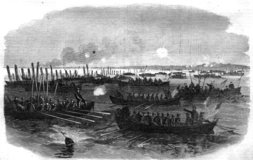
Capture of Wilmington, North Carolina, by the U.S. Navy
When Benjamin was 73 years old, the bloodiest conflict in American history began. The Civil War claimed the lives of over 600,000 Americans, and Benjamin saw families in his community divided just as the nation was. North Carolina provided the most soldiers of any state for the Confederacy - over 135,000; one-sixth of these men succumbed to disease, while another one-sixth were casualties of actual battle. The Union army welcomed the services of an additional 8,000 men from North Carolina, almost half of whom were African-American.
Women converted houses into hospitals, working as nurses to aid the dying soldiers. Meat was scarce, and shoes were impossible to buy at any price. Food costs skyrocketed during this time, and citizens struggled to provide for their families. In 1860, a meal for an average family cost $6.55; in 1863, the same food cost almost ten times that amount.
The northeastern portion of North Carolina was occupied by the Union navy as early as the spring of 1862. Guerrilla fighters, unbound by the rules of combat, waged terrifying war in the mountains, and horror stories of these attacks were spread through Benjamin's community.
North Carolina experienced one of the war's most devastating events, as General Sherman's "March to the Sea" moved across the state. After leaving South Carolina in smoldering ruins, they moved into North Carolina, where Union soldiers destroyed everything in their path en route to Savannah, Georgia. Homes and public buildings burned to the ground, animals were shot, and all of the food they found was consumed.
The last major battle of the Civil War took place in Benjamin's home state, as General Joseph E. Johnston engaged General William T. Sherman’s forces on March 19, 1865 at Bentonville. The South surrendered shortly thereafter, and the Union was preserved. There was a mix of despair and relief as the war ended in North Carolina, and the people around Benjamin knew that repairing the wounds of those years would likely take decades to come.
Homestead Act, 1862
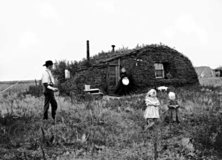
A homestead on the American frontier
When Benjamin was 74 years old, many Americans were excited to learn about the Homestead Act. This act allowed citizens to claim up to 160 acres of free land in the West, inspiring many people to pack their belongings and head for the frontier with the hopes of establishing a successful farm and a new life. In order to keep the land they wanted, homesteaders had to "prove their claim," which meant they needed to make improvements, build a house, and farm the land for five years. Not everyone was able to take advantage of this opportunity, however, as many people did not have the financial means to travel west, run a farm, or build a house. Additionally, the land that homesteaders were given often came from Native Americans, who were forced to give up their land and move to reservations across the West.
Lincoln Assassination, 1865

Ford's Theater, where President Lincoln was assassinated
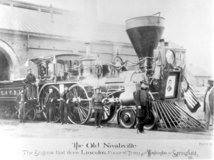
On April 15, 1865, when Benjamin was 77, President Abraham Lincoln was assassinated by John Wilkes Booth while attending a play at Ford's Theatre. The Civil War had officially ended just five days earlier, and a furious and vengeful Booth supported the defeated Confederacy. Americans like Benjamin learned about the President's death quickly as flags were at half-staff and businesses were closed by the next day. Millions of Benjamin's fellow countrymen attended open-casket viewings as a train carried Lincoln's body on a winding journey from Washington DC to Illinois, passing through Pennsylvania, New York, Ohio, and several other states. The end of the bloody and destructive war, which had been a time of rejoicing for many Americans, had now become a time to mourn.
13th Amendment, 1865
After the Civil War ended in 1865, when Benjamin was 77, the 13th Amendment was passed, freeing all slaves within the United States. Black citizens and some white Americans celebrated across the United States, but they also knew and felt racist sentiments that had grown through decades of slavery and oppression. Shortly after their readmission to the Union, many Southern states began to pass "Black Codes" to restrict the freedoms of former slaves. Many new laws included provisions stating that black men must have written documentation of employment, while others sought to restrict African Americans from holding any profession except farm laborer. As a result, many former slaves worked as sharecroppers on land owned by wealthy farmers and paid part of their crop as rent. Unfortunately, the poverty and poor living conditions most sharecroppers endured were not much different from what they had experienced as slaves.
First Transatlantic Cable, 1866
In 1866, when Benjamin was 78, a permanent telegraph line was laid across the Atlantic Ocean by the British ship, Great Eastern. This was eight years after the creation and eventual failure of the first attempt at a transatlantic cable. This new line was able to re-establish communication between England and North America and sustain it—enabling messages to be delivered long distance in a matter of minutes rather than days by steamship.
The Lowry War, 1866
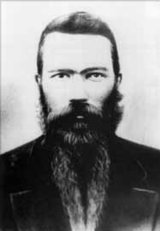
Henry Berry Lowry
Henry Berry Lowry was a member of the Lumbee Native American tribe. In 1866, rumors and tales about Lowry and his gang ran rampant in 78-year-old Benjamin's home state of North Carolina, as locals followed stories of their exploits.
During the Civil War, many Lumbee tribesmen were conscripted into the Confederate Army to work on Fort Fisher. In defiance, many escaped to the surrounding woods and swamps, and Henry Berry Lowry, along with father Allen and several brothers, were among them. In December of 1864, the Lowrys—with an uprising on their minds—stole hogs from a wealthy local, then killed a neighbor who pursued them. The family then turned their attention to J. Brantley Harriss, a white man who had murdered several Lowry cousins. They executed him in retaliation. Motivated by more revenge, the Lowrys stole guns and ammunition and began to perform raids on wealthy landowners in the area.
Allen Lowry was apprehended, a trial was held, and he and a son, William, were executed. Henry Berry Lowry witnessed the executions of his father and brother and swore vengeance again. He began leading more organized raids upon wealthy farmers, killing any officers who came to arrest him.
In 1872, Lowry simply disappeared, with no one ever claiming the bounty the North Carolina government put on him. Stories conflicted as to what happened, but the raids ceased, bringing an end to the Lowry War.
Heinz Ketchup, 1869
When Benjamin was 81, the Heinz company, founded by Henry Heinz, began producing what would become one of America's favorite condiments—ketchup. With its distinctive keystone-shaped glass bottle, Heinz Ketchup was one of America's first packaged foods available to Benjamin. The popularity of Heinz ketchup caused a surge in pre-packaged foods in America.
Elizabeth Susan Stephenson dies, 1871
Benjamin's child Elizabeth Susan Stephenson passed away in North Carolina, United States at the age of 43. Benjamin was 83.
Blue Jeans, 1873
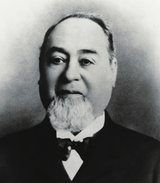
Levi Strauss
In 1873, when Benjamin was 85, a German immigrant named Levi Strauss patented denim pants, which would later be known as jeans. Blue jeans, which Strauss had actually invented years earlier, soon became commonly worn by miners and farmers in Benjamin's country. Eventually, blue jeans revolutionized the world of fashion, becoming a staple in many closets in the U.S. and around the world.
Typewriter, 1873
While earlier versions of the typewriter had been previously released, it wasn't until 1873, when Benjamin was 85, that Christopher Latham Sholes' machine became popular with the general public. Though early typewriters usually cost around $100 US dollars (about $2,000 by today's standards), the costs dropped as the machines became more popular and production methods improved. The speed made possible by the typewriter revolutionized written communication for everything from letters to novels, and by the start of the 20th century, the heavy piece of equipment became ubiquitous in both homes and offices across the United States.
Benjamin dies, 1873
Benjamin died when he was 85 years old in Northampton, North Carolina, United States.
Jenkins Stephenson dies, 1873
Benjamin's child Jenkins Stephenson passed away in North Carolina, United States at the age of 58 (unsure of Jenkins's death). Benjamin was 85.